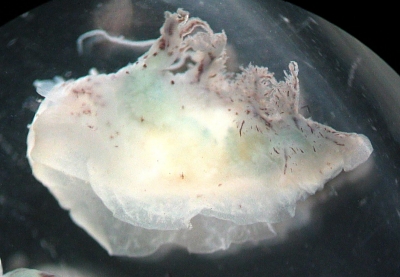New observations on Pseudobornella orientalis
June 19, 2006
From: Song Xikun

Dear Bill,
After checking the original paper of Baba (1932) concerning Pseudobornella orientalis and all images in this forum that have been identified as P. orientalis, I think we might have been made some mistakes. In other words, some images might be not P. orientalis, at least different from the original animals discribed by Baba.
So, first of all, let us recall the descriptions of Baba:
(1) Habitat: According to Mr. Komori, Baba's specimens were found feeding on Tubularia mesembryanthemum Allman attached to Zostera at highwater mark in the front of the Misaki Marine Biological Station in May, 1931.
(2) According to a brief note by Mr. Komori, Baba's specimens bear numerous small irregular chocolate-coloured mottlings on the whole dorsal surface of the body. Small yellow lines are also visible on the back.The preserved specimen retains the chocolate-coloured mottlings on the translucent yellow ground of the body above.
Based on field surveys upon nudibranchs on Tubularia mesembryanthemum conducted during 2004-2006, I always found P. orientalis during December to the next May. When T. mesembryanthemum disappeared, the nudibranch disappeared, too. So P. orientalis shows high feeding specialization upon Tubularia mesembryanthemum. A possible reason for this association is that larvae of P. orientalis metamorphose only in the presence of its adult prey, Tubularia mesembryanthemum. If there are enough prey, the predator will survive. So when we collect P. orientalis, there must be T. mesembryanthemum nearby. For that reason I think the nudibranch I collected is the same as Baba's.
I have attached two images of a preserved specimen collected in the colony of Tubularia mesembryanthemum. I think this is what Baba would have seen in 1932. Notice the chocolate-coloured mottlings and long slender tentacles.
The images of Nishina Masayoshi are the common mode of P. orientalis, while those of Haruo Kinoshita and Tomohiko Kurihara seem to be different.
The last story is that all their images are found in sand, not the Tubularia colony. Maybe there are Tubularia nearby. Since my nudibranchs are all collected in fishnig nets, I have no chance to collect them in sand. Up until now, Pseudobornella contains only one species, but it is possible there might be other species in this genus.
Locality: Daisong Bay, 1-2 m, China, Taiwan Strait, 16 June 2006. Length: 12 mm. Photographer: Song.
Song Xikun
xksong@xmu.edu.cn
Song, X.K., 2006 (Jun 19) New observations on Pseudobornella orientalis. [Message in] Sea Slug Forum. Australian Museum, Sydney. Available from http://www.seaslugforum.net/find/16895
Dear Song,
Thanks for the confirmation that it feeds on Tubularia. However your comment that "A possible reason for this association is that larvae of P. orientalis metamorphose only in the presence of its adult prey, Tubularia" This is a bit like asking what came first - the chicken or the egg? Pseudobornella has evolved a close association with Tubularia, on which it feeds, and part of that association may be to trigger metamorphosis and settlement in veliger larvae. You can't say it feeds on Tubularia because that is what the larvae settle on - the reason the veliger settle on Tubularia is because the species has evolved a feeding association woth that hydroid.
I am not sure I see the differences you suspect in the different photos. To me the colour differences seem part of a normal range, but I am handicapped by never seeing this species alive. I look forward to further observations.
Best wishes,
Bill Rudman
Related messages
-
Re: Is this Pseudobornella orientalis?
From: Song XiKun, October 24, 2005 -
Is this Pseudobornella orientalis?
From: XiKun Song, October 20, 2005 -
Re: Pseudobornella orientalis from Philippines
From: Tomohiko Kurihara, March 25, 2004 -
Pseudobornella orientalis from Philippines
From: Shinji Kitagawa, March 19, 2004 -
Pseudobornella orientalis from the Japan Sea
From: Shigeru Hayashi, July 15, 2002 -
Pseudobornella orientalis from Izu Penisula, Japan.
From: Haruo Kinoshita, May 14, 2002 -
Information on Pseudobornella orientalis
From: Nishina Masayoshi, May 14, 2002 -
Pseudobornella orientalis from Japan
From: Tomohiko Kurihara, May 1, 2002 -
Pseudobornella orientalis
From: Nishina Masayoshi , April 16, 2002
